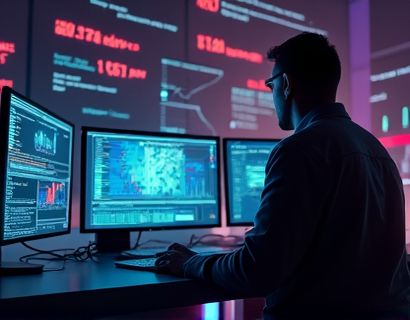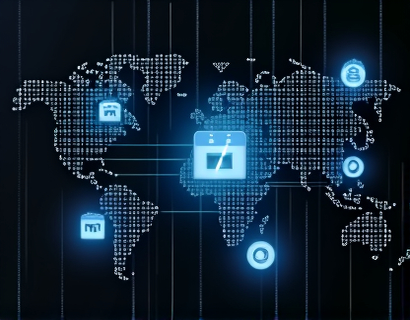Blockchain-Powered Asset Tokenization: Bridging Physical Assets with Digital Liquidity for Enhanced Market Accessibility
In the rapidly evolving landscape of finance and asset management, blockchain technology has emerged as a transformative force, offering unprecedented opportunities for enhancing liquidity and market accessibility. One of the most promising applications of blockchain is asset tokenization, a process that involves converting real-world assets into digital tokens on a blockchain network. This innovative approach not only secures and verifies the ownership of physical assets but also integrates them into a transparent and efficient digital ecosystem. By doing so, it significantly broadens the scope of investment opportunities and streamlines asset management for both individuals and institutions.
The concept of asset tokenization is rooted in the fundamental principles of blockchain technology: decentralization, transparency, and immutability. Traditional asset management often involves cumbersome processes, high transaction costs, and limited liquidity, particularly for illiquid assets such as real estate, art, and infrastructure. Asset tokenization addresses these challenges by representing physical assets as digital tokens, which can be easily bought, sold, and traded on blockchain platforms. This digital representation ensures that the ownership and value of the underlying asset are accurately reflected in the token, providing a seamless bridge between the physical and digital worlds.
Enhancing Liquidity through Tokenization
One of the primary benefits of asset tokenization is the enhancement of liquidity. In traditional markets, illiquid assets often require lengthy and complex transactions, making it difficult for owners to quickly convert their holdings into cash. Tokenization simplifies this process by breaking down large assets into smaller, tradable units. These tokens can be bought and sold on decentralized exchanges or traditional stock exchanges, allowing for rapid and efficient transactions. This increased liquidity attracts a broader range of investors, including those who previously could not participate due to the high minimum investment requirements of illiquid assets.
For instance, consider a commercial real estate property valued at millions of dollars. Traditionally, investing in such property would require substantial capital and a lengthy due diligence process. With tokenization, this property can be divided into thousands of tokens, each representing a fraction of the property's value. Investors can purchase these tokens with relatively small amounts of capital, thereby democratizing access to real estate investments. This not only increases the pool of potential investors but also enhances the overall market efficiency by reducing the time and cost associated with asset transactions.
Improving Market Accessibility
Asset tokenization also significantly improves market accessibility by lowering barriers to entry. Traditional asset markets are often dominated by institutional investors and high-net-worth individuals due to the high costs and complexities involved. Tokenization democratizes access by allowing retail investors to participate in a wider range of asset classes. The transparency and security provided by blockchain technology further enhance trust and confidence among new investors, encouraging more people to explore investment opportunities that were previously out of reach.
Moreover, tokenization facilitates global market access. Digital tokens can be traded 24/7, regardless of geographical boundaries, enabling investors from around the world to participate in the market. This global reach not only increases the liquidity of assets but also fosters a more interconnected and efficient global financial system. For example, an artist looking to tokenize a piece of art can reach a global audience of collectors and enthusiasts, expanding the potential market for their work beyond local or regional constraints.
Ensuring Security and Transparency
The security and transparency offered by blockchain technology are crucial components of successful asset tokenization. Blockchain's decentralized and immutable ledger ensures that all transactions related to the tokenized asset are recorded in a tamper-proof manner. This transparency builds trust among market participants, as they can verify the ownership and transaction history of the asset with ease. The reduced need for intermediaries, such as banks and legal entities, not only lowers transaction costs but also minimizes the risk of fraud and errors.
Smart contracts, self-executing contracts with the terms directly written into code, play a pivotal role in asset tokenization. These contracts automatically enforce and execute the terms of the transaction, ensuring that all parties adhere to the agreed-upon conditions. For example, a smart contract can automatically transfer ownership of a token to a buyer once the payment is confirmed, eliminating the need for manual processing and reducing the potential for disputes. This automation not only speeds up the transaction process but also enhances the overall reliability of the system.
Use Cases and Industries
The applications of asset tokenization extend across various industries, each benefiting from the unique advantages it offers. Real estate, as mentioned earlier, is one of the most prominent sectors, but other areas such as art, commodities, and infrastructure are also seeing significant transformations.
In the art world, tokenization is revolutionizing the way artworks are bought, sold, and owned. Artists and collectors can tokenize unique pieces, creating fractional ownership models that were previously impossible. This not only increases the liquidity of art assets but also makes high-value art more accessible to a broader audience. For instance, a rare painting can be divided into multiple tokens, allowing multiple investors to own fractions of the artwork, thereby spreading the risk and increasing market participation.
The commodities sector, including precious metals and energy resources, is another area where tokenization is making a substantial impact. Tokenized representations of physical commodities can be traded on blockchain platforms, providing investors with a new way to hedge against price fluctuations and diversify their portfolios. This tokenized approach also enhances transparency and traceability, ensuring that the commodities are genuinely backed by physical assets.
Infrastructure projects, often requiring significant upfront investment and long-term returns, benefit from tokenization by attracting a wider range of investors. Tokenized infrastructure assets can be sold to investors in smaller units, making it feasible for individuals and smaller institutions to participate in these projects. This not only diversifies the investor base but also helps in securing the necessary funding for large-scale infrastructure developments.
Challenges and Considerations
Despite its numerous advantages, asset tokenization is not without challenges. Regulatory uncertainty remains a significant hurdle, as different jurisdictions have varying approaches to blockchain and tokenized assets. Ensuring compliance with local laws and regulations is crucial for the successful implementation of tokenization projects. Additionally, the technical complexity of blockchain technology can be a barrier for some organizations, requiring expertise in blockchain development and management.
Another consideration is the environmental impact of blockchain networks, particularly those using proof-of-work consensus mechanisms. The energy consumption associated with these networks has raised concerns, prompting the industry to explore more sustainable alternatives such as proof-of-stake. As the market evolves, addressing these environmental concerns will be essential for the long-term viability of asset tokenization.
Future Prospects
The future of asset tokenization looks promising, with ongoing advancements in blockchain technology addressing current challenges and opening new possibilities. The development of more efficient consensus mechanisms, improved scalability solutions, and enhanced interoperability between different blockchain platforms will further solidify the role of tokenization in the financial ecosystem.
Moreover, the integration of asset tokenization with other emerging technologies, such as the Internet of Things (IoT) and artificial intelligence (AI), holds the potential to create more intelligent and automated asset management systems. For example, IoT devices can provide real-time data on the condition and usage of physical assets, which can be integrated with blockchain to ensure accurate and up-to-date token valuations.
In conclusion, blockchain-powered asset tokenization is a game-changer in the world of asset management, offering enhanced liquidity, improved market accessibility, and increased security and transparency. As the technology matures and regulatory frameworks evolve, the potential for tokenization to transform various industries and empower a broader range of investors is immense. Embracing this innovation can lead to more efficient, inclusive, and dynamic financial markets.










































